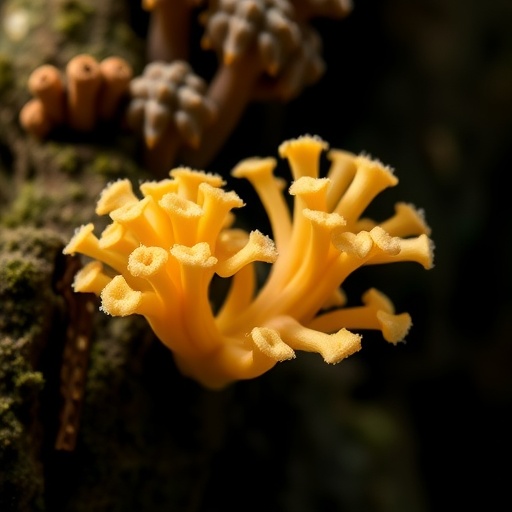A groundbreaking study led by Professor Liu from the Institute of Microbiology at the Chinese Academy of Sciences has unveiled a promising new frontier in the fight against cryptococcosis—a lethal fungal infection responsible for over 600,000 deaths worldwide annually. The current therapeutic arsenal, including amphotericin B (AmB), fluconazole (FLC), and flucytosine (5-FC), is marred by high toxicity, emerging drug resistance, and prohibitive costs. These limitations underscore an urgent and unmet medical need for safer, more effective antifungal agents. Addressing this challenge, the research team has isolated three novel phenolic bisabolane sesquiterpenoid (PBS) derivatives alongside twelve known analogues from the marine-derived fungus Aspergillus sydowii LF51, introducing fresh molecular scaffolds with potent antifungal potential.
This discovery leveraged sophisticated tools—molecular networking and SMART (Small Molecule Accurate Recognition Technology) approaches—to efficiently pinpoint and characterize bioactive compounds within complex fungal extracts. Such integrative methods represent the cutting edge in natural product chemistry, enabling researchers to accelerate the identification of novel molecules with therapeutic relevance. Notably, the isolation of (±)-aspersydonol A (1a/1b) and aspersydonol B (2) marked a significant milestone, with compound 2 distinguished as the first natural PBS harboring a hexahydrodibenzo[b,d]furan nucleus, expanding the chemical space of bisabolane sesquiterpenoids considerably.
The meticulous structural elucidation of these compounds involved an array of spectroscopic analyses including nuclear magnetic resonance (NMR) spectroscopy and electronic circular dichroism (ECD) calculations. These techniques collectively enabled the determination of absolute configurations and subtle stereochemical nuances essential for understanding bioactivity relationships. Such rigorous characterization lays the foundation for subsequent medicinal chemistry optimization and offers insights into the molecular underpinnings of antifungal efficacy.
Antifungal bioassays further illuminated the therapeutic promise of this compound library. Among the tested derivatives, compounds 3, 6, 9, and 11 demonstrated moderate inhibitory activity against Cryptococcus species, with minimum inhibitory concentrations (MICs) ranging from 32 to 64 μg/mL. Although moderate, these activities gain significance considering their synergistic potential when combined with existing antifungals. Specifically, co-administration of these PBS compounds with amphotericin B resulted in additive effects, significantly lowering MICs to 4–32 μg/mL against Cryptococcus gattii R265, a pathogenic strain notorious for causing severe infections.
Compound 9 exhibited an especially fascinating profile, displaying an additive effect with fluconazole against C. gattii R265 and reducing its MIC to a strikingly low 2 μg/mL. This synergy suggests a unique mechanistic complementarity, offering avenues to overcome resistance barriers typically encountered in cryptococcal infections. Harnessing such additive interactions could drastically enhance current therapeutic regimens while mitigating drug toxicity through dose reductions.
Delving deeper into the mode of action, mechanistic studies revealed that compound 9 exerts its antifungal effects via multiple pathways. It suppresses urease activity—a critical enzyme for fungal virulence and survival in host environments—disrupts membrane integrity, and induces oxidative stress through reactive oxygen species (ROS) accumulation. The multi-pronged attack suggests a robust antifungal mechanism that could minimize the emergence of resistance and enhance treatment durability.
The identification of phenolic bisabolane sesquiterpenoids from marine fungi also emphasizes the untapped potential of marine biodiversity as a reservoir for drug discovery. Aspergillus sydowii, isolated from marine habitats, has historically been a rich source of bioactive secondary metabolites. This study reinforces the value of exploring marine microorganisms, which possess unique biosynthetic capabilities shaped by their environmental niches, leading to structurally novel and biologically potent chemical entities.
Importantly, the study’s integration of in-depth spectroscopic characterization with functional bioassays and mechanistic analyses embodies the comprehensive approach required for modern drug discovery. By bridging natural product chemistry with pharmacological evaluation, the research navigates from molecule identification to preliminary insights into therapeutic relevance, thereby streamlining the drug development pipeline.
Such innovative findings hold tangible promise for addressing the global health burden posed by cryptococcosis, especially in regions where access to current antifungal medications is limited by cost and side effects. The emergence of novel, effective, and potentially safer antifungal agents derived from marine fungi could revolutionize treatment paradigms, reduce mortality rates, and improve patient outcomes.
Moreover, the notion of leveraging additive effects with existing drugs like amphotericin B and fluconazole may provide a strategic route to optimize therapy—enhancing efficacy while possibly curbing the adverse events linked to high-dose monotherapies. This concept could be transformative in clinical mycology, where drug resistance and toxicity remain formidable challenges.
The molecular insights gained into the unique hexahydrodibenzo[b,d]furan skeleton present in compound 2 also open up exciting avenues for synthetic chemists. This novel scaffold can serve as a springboard for synthetic modifications aimed at enhancing potency, selectivity, and pharmacokinetic properties, potentially leading to the development of a new class of antifungal agents.
Looking ahead, further investigations are warranted to explore the pharmacodynamics, toxicity profiles, and in vivo efficacy of these compounds. As the marine-derived PBS analogues enter subsequent stages of preclinical development, their full therapeutic potential against cryptococcosis and potentially other fungal infections could be realized.
In conclusion, this landmark study not only expands the chemical diversity of phenolic bisabolane sesquiterpenoids but also showcases their promising antifungal activities against critical Cryptococcus pathogens. The marriage of marine natural product discovery with advanced analytical and mechanistic studies exemplifies a paradigm shift in the search for next-generation antifungal therapeutics, offering hope against a devastating global health threat.
Subject of Research: Phenolic bisabolane sesquiterpenoids isolated from marine-derived Aspergillus sydowii and their antifungal activity against Cryptococcus species.
Article Title: New phenolic bisabolane sesquiterpenoids discovered from the marine-derived fungus Aspergillus sydowii assisted by molecular networking and SMART strategies
News Publication Date: 14-Sep-2025
Web References: http://dx.doi.org/10.1080/21501203.2025.2547630
Image Credits: Mycology
Keywords: Cryptococcosis, antifungal agents, phenolic bisabolane sesquiterpenoids, Aspergillus sydowii, marine natural products, molecular networking, SMART technology, amphotericin B synergy, fluconazole synergy, urease inhibition, reactive oxygen species, membrane disruption




